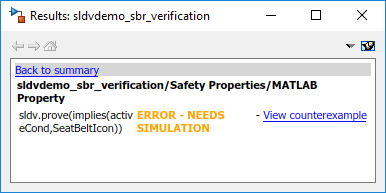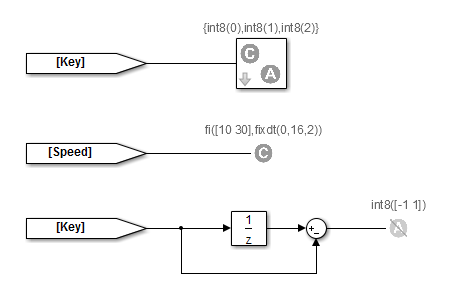使用验证模型证明系统级属性
此示例展示了如何使用验证模型来证明系统级属性。
何时使用验证模型进行属性证明
如果您的模型具有影响模型行为的系统范围的属性,您可能希望在不改变设计模型的情况下证明这些属性。为此,您需要创建一个验证模型,其中包括:
引用设计模型的 Model 模块
定义属性和任何所需约束的一个或多个验证子系统
关于此示例
设计模型 sldvdemo_sbr_design 为安全带提醒灯的逻辑建模。如果打开点火开关,安全带未系好,且车辆超过一定速度,安全带提醒灯就会亮起。
sldvdemo_sbr_verification 模型是一个验证模型,它定义了一些约束,并验证了 sldvdemo_sbr_design 模型中的属性。验证模型中的 Model 模块引用了设计模型,因此验证逻辑只存在于验证模型中。
由于约束被禁用, sldvdemo_sbr_verification 模型包含一个被伪造的属性。在 sldvdemo_sbr_verification_fixed 模型中,约束被启用并且所有属性都被证明有效。
了解验证模型
请按照以下步骤了解验证模型的工作原理:
1.打开验证模型:
open_system('sldvdemo_sbr_verification')设计 Model 模块是引用 sldvdemo_sbr_design 的 Model 模块。设计模型中的 SBR Stateflow® 图假设 KEY 输入最初为 0。
2.打开指定您想要证明的设计模型的属性的 Safety Properties 子系统。
该子系统包含一个名为 MATLAB 属性的 MATLAB Function 模块。该模块中的代码指定了当点火开关打开、安全带未系好且速度低于 15 时应开启安全带提醒器的属性:
3.关闭 Safety Properties 子系统。
4.打开 Input Constraints 子系统。
该子系统定义了以下约束:
该键可以处于三个位置:0、1、2
速度被限制在 10 到 30 之间。
密钥必须从 0 开始,并且每次只能改变一个增量。例如,密钥可以从 0 变为 1 或从 1 变为 2,但不能从 0 变为 2。在本验证模型中,该约束未启用。
5.关闭 Input Constraints 子系统,但保持 sldvdemo_sbr_verification 模型打开。
证明设计模型的性质
分析 sldvdemo_sbr_verification 模型来证明以下属性:
1.在 sldvdemo_sbr_verification 模型窗口中,要开始分析,点击 Design Verifier 选项卡上的 Prove Properties 以开始分析。
当分析完成时,Simulink® Design Verifier[tm] 日志窗口会显示一个目标被证伪 - 需要仿真。有关详细信息,请参阅 目标被证伪 - 需要仿真。
2.要查看哪个目标被证伪,点击突出显示模型上的分析结果。
Safety Properties 子系统以橙色突出显示。
3.打开 Safety Properties 子系统并点击 MATLAB 属性模块。
Simulink® Design Verifier™ 结果窗口表明语句 sldv.prove(implies(activeCond,SeatBeltIcon)) 在至少一个时间步内为错误。

4.点击查看反例即可查看违反该属性的信号值。sldvdemo_sbr_verification_harness 模型 以 Counterexample_1 作为输入打开。双击 Counterexample_1 打开带有反例的 Signal Editor 模块。点击“打开信号编辑器”按钮 ![]() 以可视化输入。KEY 输入最初为 2,无效。
以可视化输入。KEY 输入最初为 2,无效。
为了验证 Safety Properties 子系统中指定的属性,您必须确保 KEY 的初始值为 0。
修复验证模型
验证模型中的 Input Constraints 子系统包含三个约束。第三个约束要求 KEY 的初始值为 0,并且 KEY 只能以 1 的增量变化,这个约束被禁用。

要查看启用第三个约束时如何验证此属性:
1.在 sldvdemo_sbr_verification 模型中,点击打开固定模型。
sldvdemo_sbr_verification_fixed 验证模型打开。
2.打开 Input Constraints 子系统。
现在启用第三个约束,以便 KEY 的初始值为 0,并且以 1 的增量变化。
3.关闭 Input Constraints 子系统。
4.要开始分析,点击 Design Verifier 选项卡上的证明属性。
分析证明了该属性的有效性。